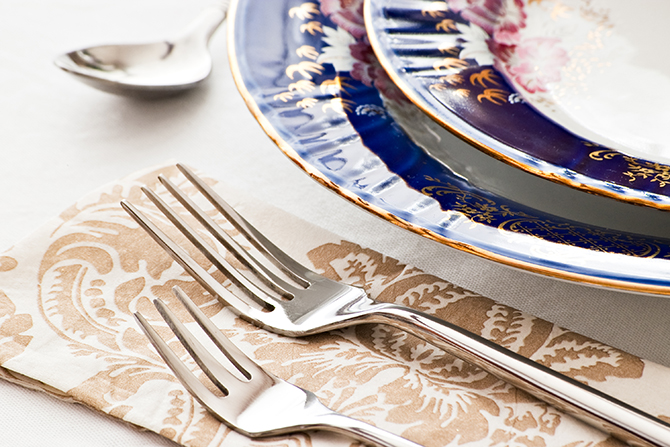Want to make a good impression when entertaining friends or family? Think you know the basic principles of table setting? There’s nothing quite like the feeling of effortless perfection that comes with an artfully laid table. But what if we told you there’s more to it than just plates and cutlery?
Table setting etiquette is quite complex, and many of us either need to learn it or need refreshing. But don’t worry – we’ve got your back! In this article, we’ll teach you the basics of proper table setting so that you ensure that all your dinners are as polished as possible. We’ll show you how to set the perfect table for any occasion and give you some tips on decorating effortlessly. So let’s get started!
Types of Tableware for Everyday Dining
If you want to set the perfect table, you’ll need the right tableware. Of course, what type of tableware you need depends on the occasion and how many courses are being served. But for everyday dining, you should have four essential items: plates, glasses, silverware, and napkins.
Plates are typically round or square; the main course is generally served on the largest plate. Smaller plates may be used for side dishes or desserts. Depending on your preference, you can use one or a combination of different sizes for your setup.
Glasses come in various shapes and sizes for different types of beverages. Water glasses are sometimes smaller than wine glasses, and champagne flutes may be narrower than other types. Generally speaking, though, it’s nice to have at least two sizes—one slightly smaller and one slightly larger—for various types of beverages.
Silverware usually consists of various sizes of knives, spoons, and forks, depending on the meal served. The placement should be done in order of use; knives should go on the right side with blades facing the plate, spoons go to the right, and forks should be placed on the left side.
Finally, napkins can also vary depending on your occasion or style preference, with paper napkins often used when entertaining guests. Place each napkin above your plate— either folded in half lengthwise or rolled up—with a knife placed partially underneath it if desired.
Placement Guidelines for Plates, Glasses, and Utensils
If you want to find the basics of a proper table setting click here. There are a few placement guidelines you should keep in mind when it comes to place settings.
For starters, your plate should be placed in the center of your setting. To the left of this plate, line up all your utensils, starting with those you’ll use first (usually working from the outside in). Keep this order consistent—it’s often helpful to remember that forks go on the left and knives and spoons go on the right.
When in doubt about what goes where, here’s a helpful tip: think clockwise. This means that soup spoons are placed to the right of knives and other larger utensils. Place the glasses you may use on the plate’s upper-right side. Then glasses are placed above them at 6 o’clock with small butter or dessert dishes across from them (at 12 o’clock) if necessary.
Finally, if an extra cup or bowl is used for specialty items (like a gravy bowl or oyster shell), it can usually go right between your water glass and dinner plate! Following these simple guidelines will ensure your table looks stunning with any dinnerware combination.
Rules for Formal and Informal Table Settings
In addition to knowing the basics of table setting, it’s essential to understand the difference between a formal and informal table setting. Rule number one is always to use the right table setting when dining.
Formal Table Setting
A formal table setting typically includes more place settings, such as multiple glasses, plates, and flatware. It also incorporates decorative elements like name cards and other ornate decorations. Here are some of the basics of a formal table setting:
- Place your napkin on your lap as soon as you sit at the table.
- Utensils should be placed in order from outside in; It is standard for folks to be positioned to the left side of the plate, with both spoons and knives being placed to the right.
- Dinner plates should be placed an inch from the edge of the table.
- Smaller dishes like bread plates should be placed above the forks.
- Glasses should be arranged above and slightly to the right of each plate.
Informal Table Setting
An informal table setting is usually much more straightforward than a formal setting. It typically uses fewer pieces and has fewer decorative elements. Here are some tips for setting a casual yet stylish table:
Utensils can still be laid out in order from the outside in; however, all utensils may not be necessary if fewer courses are served.
- Dinner plates can be slightly closer to the edge of the table than with a formal setting.
- Depending on available space, glasses can go next to each plate or above them.
- Bread plates may only be needed if there is an appetizer before dinner.
- For everyday meals, an informal table setting is usually recommended.
Tips to Help You Remember the “Rules” of Table Setting Etiquette
No one wants to be that person who serves their guests at an awkwardly set table. Thankfully, taking the time to learn the basics of table-setting etiquette will ensure that everything looks professional and polished. Here are a few tips to help make sure you never forget:
Make it Clear
When laying out the table, think about contrast. Choose placemats, tablecloths, and napkins that contrast with the china and silverware, making everything easy to distinguish. This will also help your guests know exactly where to place their utensils throughout their meals.
Levels of Elegance
If you’re hosting a fancier event, add multiple levels of elegance with extra pieces like hors d’oeuvres plates and chargers. This is also a great way to take your table setting up a notch if you’re throwing an impromptu dinner party and don’t have time for too much preparation.
Put it In Writing
Find some image inspiration online or in magazines and make yourself a handy reference guide for any occasion — this will help you remember the exact order each piece of silverware should be placed in! Writing down can also reduce stress levels when setting up for more significant events.
By remembering these few tips, you can easily create beautiful tablescapes that will leave your guests in awe!
Conclusion
Whether hosting a formal dinner party or a casual get-together, table-setting etiquette is integral to making guests feel at home. With just a few basic guidelines, your table will look inviting, attractive, and appropriate for the occasion. By understanding the basics of table-setting etiquette, you can confidently entertain and bring together people of all backgrounds. From the silverware and glasses placed in the proper order to the centerpiece and seating arrangements, applying the fundamentals of table setting etiquette ensures your table looks lovely no matter the occasion.






